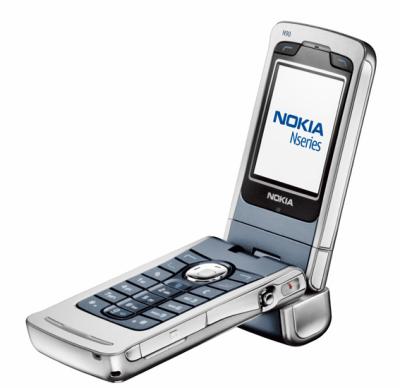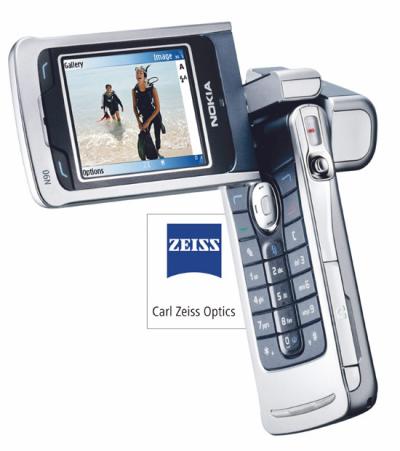

Camera phones with high quality Carl Zeiss lenses make many photographers' shutter fingers itchy. These new camera phones have 2 megapixel or higher image resolution and they also come with camera features, such as auto-focus and exposure control. We compared the image quality of a 2 megapixel Nokia N90 to a compact digital camera, to find out if the amateur photographer can survive without a dedicated camera.
Before we begin looking at photos, we'd like to remind you that the number of megapixels isn't an indication of image quality, it’s only the dimensions of an image, and it can also mean a greater level of detail in the image. Photo quality depends on the camera optics, image sensor and the software inside the camera that converts the captured light into a picture that we see as a JPG image.
A 2 megapixel photo looks excellent on a large computer monitor or when viewed as a slideshow on a TV. 2 megapixel photos are sufficient for getting high quality print outs in 4x6inch/10x15cm size on a home printer or at a photo lab. Having more megapixels allows you to print out larger pictures in high quality.
All pictures were taken in full automatic mode and without changing any settings in either camera. Photos have been cropped from their full 1600x1200 pixel resolution, but not resized. You can see the full-size image by clicking on the photo (a new window opens up).
First, let's examine photos taken in daylight and indoors.
The indoors image captured by the digital camera is clearer than the picture taken with the camera phone. Low light is challenging for any camera and you can see some extra fuzziness and red tone in the camera phone photo. Yet, it's a huge improvement on the previous generation of camera phones, just compare these photos with pictures taken on a 0.3 megapixel VGA resolution camera phone.BELOW THIS POST
Next, we snapped photos in darkness. It is a very demanding situation for a camera's auto-focus system and a real challenge for the flash.
The auto-focus system in the digital camera is more accurate in this situation and with its more powerful flash; the result is better than that of a camera phone. The Nokia N90 also adds some extra red tone into the image.
Although camera phones are not (yet) equipped with optical zoom, there are plenty of opportunities to take pictures outdoors. Often, the beauty is in the details in outdoors photos; beautiful landscapes are actually quite difficult to frame.
Photos taken outdoors on the Nokia N90 proved to be very nice. You can see plenty of detail at the front of the picture where we locked the auto-focus. In fact, the auto-focus system found the the hay at the front, while we couldn't lock the digital camera on the small object at all. That's why both photos above are focused a little bit further and not on the nearest hay. In any case, the digital camera image shows more details and its color balance is better.
We didn't compare the Nokia N90 with another 2 or 3 megapixel camera phone, because its photographic features will make many people consider the product as their only camera. If we conveniently forget all the other functionality of the Nokia N90, such as MP3 player, video recorder, email and broadband speed (3G UMTS and EDGE) Internet access, we could budget for an alternative set of devices.
For a SIM-free/unlocked price of a 2 or 3 megapixel camera phone (500-700 USD/EUR), which is equipped with a camera lens and auto-focus, you can also get a mid-range phone (300-450 USD/EUR) and a mid-range 3-5 megapixel compact digital camera (200-400 USD/EUR).
If you want to be absolutely sure you always have a camera with you, go for a high-end camera phone – the image quality is good, especially in outdoors pictures. Many holiday photographers only need a product like the N90 for keeping their sunny memories. For indoors or sports photography, capturing distant objects with a zoom, or if you believe you'll be getting serious with photography, consider a dedicated digital camera and a phone.
=====================================================================================
In the previous century, you had to wait for days to see your new photos, but you knew you would get fairly standard quality photos regardless of which film camera you happened to have. Now, you can snap every photo you ever wanted if your mobile phone features a digital camera. Using a camera phone for photos is easy, economical and fun, but first, you have to know if you will be a happy with the quality of images taken with a camera phone.
A mobile phone becomes a camera phone when it is equipped with a digital camera. The color screen in the phone is used as a viewfinder and the photos are stored in the phone's internal memory or removable memory card. Pictures can be sent to other camera phones, copied to a computer for viewing on a large screen, or posted on photo albums on the Internet.
For getting a clear picture on the quality of camera phone photos, we took a mid-range digital camera that captures high-resolution photos comparable to images captured on a high-quality film camera. We set the digital camera's resolution to two megapixels, because images of that size are close to the popular printed photo size of: 10x15 cm / 4x6 inch.
Then we took a camera phone that could capture images in VGA resolution (640x480 pixels), because it is, by far, the most popular digital camera resolution in camera phones at the moment.
The first set of sample photos have been cropped to 400x300 pixels so that they fit the screen for easy comparison, but they haven't been resized or edited with imaging software.
 |
 |
These photos were snapped at the same position, 5 meters (15 feet) away from the flowers. The VGA-size photo snapped with a camera phone is at the top and the two-megapixel digital camera image is at the bottom. |
As you can see from the photos, the digital camera produced a large image that had to be dramatically cut smaller. The larger the picture, the more memory space it takes, with a two megapixel photo requiring 500 - 1000 KB storage space for each photo. This would be too much for camera phones with limited memory space, but they can compress a VGA size photo into a 30KB file, which is possible to store in the phone and quickly send over a mobile network.
The following photos have been cropped to 300x480 pixels.
 |
 |
These close-up shots were taken with a camera phone (top) and a digital camera (bottom). |
The differences in photo quality are clearly visible, and that's the way we expect the situation to continue for the next couple of years. A camera phone is intended for capturing everyday events of our lives and a digital camera for capturing photos that will be archived and shown to grandchildren.
Although photos can look good on a camera phone's own screen, it is not an indication of photo quality in one way or another. The true colors of a photo are revealed when it is viewed on a large, high resolution computer monitor or when it is printed on paper. Also, high numbers of pixels aren't necessarily convertible to high quality photos – the more important factors are the quality of optics and software algorithms used to compose and compress the photo.
The following table summarizes some characteristics of common image resolutions used in camera phones.
Number of mega-pixels
|
Resolution in pixels
|
Viewing the photo on a computer
|
Posting the photo on a blog
|
10x15cm / 4x6" size high-quality photo print out
|
1.3
|
1280x1024
|
Yes, this will look great even as a wallpaper.
|
Yes, the blog is likely to scale down the picture size.
|
Yes.
|
1
|
1152x864
|
Yes, looks great.
|
Yes.
|
Worth a try.
|
| 0.3 | 640x480 (VGA) | Have a look, but don't expect too much. Viewing a small photo on a large screen reveals the camera quality. | Yes, but pay attention to see which photos look good on the computer screen. | Not worth the cost. |
| 0.08 (also referred to as 0.1) | 320x240 (QVGA) | You have to see it on the screen before you decide what to do with these photos. | Make sure that it looks like a photo before posting. | Not worth it. |
Examples of camera phones available in different resolutions:
320x240 QVGA resolution: Samsung SGH-P400, Sony Ericsson Z600.
640x480 VGA resolution (this is the most common resolution in camera phones): Nokia 6230, Siemens SX1.
1152x864, 1 megapixel: Nokia 7610, Sharp GX-30 (1.1 megapixel resolution, 1144 x 858 pixels).
1280x1024, 1.3 megapixels: Motorola MPx220, Siemens S65, Sprint PM-8920.
Photos taken on camera phones are great for instantly recording and sharing events in life, but for recording your sister's wedding or a holiday trip, use a digital camera. That said, we still remember the joy of receiving a message from a special person in which a photo showed a waterfall scene in Wales. The photo was captured on a VGA resolution camera phone, sent on the spot and almost instantly received in another country across the continent. Only camera phones can bring such joy to us.
[FROM MOBILE SITE]







0 comments:
Post a Comment